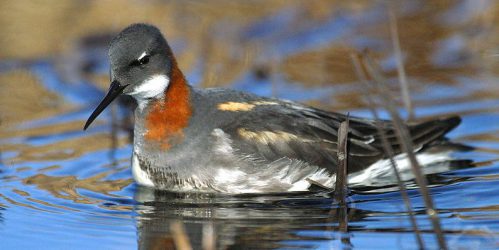The Red necked Phalarope (Phalaropus lobatus) is an extraordinary bird, a real wanderer between worlds and over the misty seas although not really big (length 19 cm). The photo below shows the appearance during the breeding season, in autumn and winter the plumage turns into a simple white / grey. As a great exception in nature, the gender roles of these birds are completely reversed, while the male birds incubate the eggs and then raise the young birds, the female birds perform the courtship dances to attract the male birds, and furthermore they also protect the breeding site against all kinds of external enemies.

Red necked Phalarope in colorful breeding dress,
Photo: U.S. Fish and Wildlife Service
Odin steals the mead of poetry while being pursued by Sittingur,
Illustration by Ólafur Brynjúlfsson, 17th century
In the ancient European saga collection ‘Edda’, the deity Odin (in the form of an eagle) steals the mead of poetry from Suttungr’s cave. This mead is a magical drink and whoever drinks it can soon recite all the information and solve any question in a flash. While Odin is pursued by Suttungr, he spits the mead of poetry into several vessels. But the chase was so fierce that some of the spit fell backwards. Therefore, everyone could now drink this part, and so poetry was finally given to mankind by a single bird.

Bird watching led by ornithologist Derk Ehlert
on the Poel Peninsula / Baltic Sea in August 2016
In Central Europe, the Red necked Phalarope can rarely be spotted on its way south in August, when it rests in the German coastal region, sometimes also in Austria at Lake Neusiedl. In August 2016, for example, I had the great fortune to see a this bird during an ornithological excursion to the Poel peninsula / Baltic Sea on an inland pond at a distance of about 200 m, because soon afterwards it was time for the birds to set off again quickly for their flight around half the way of our blue planet.
linked to:

You must be logged in to post a comment.